Raising 5,200 Children by Shovel and Machete
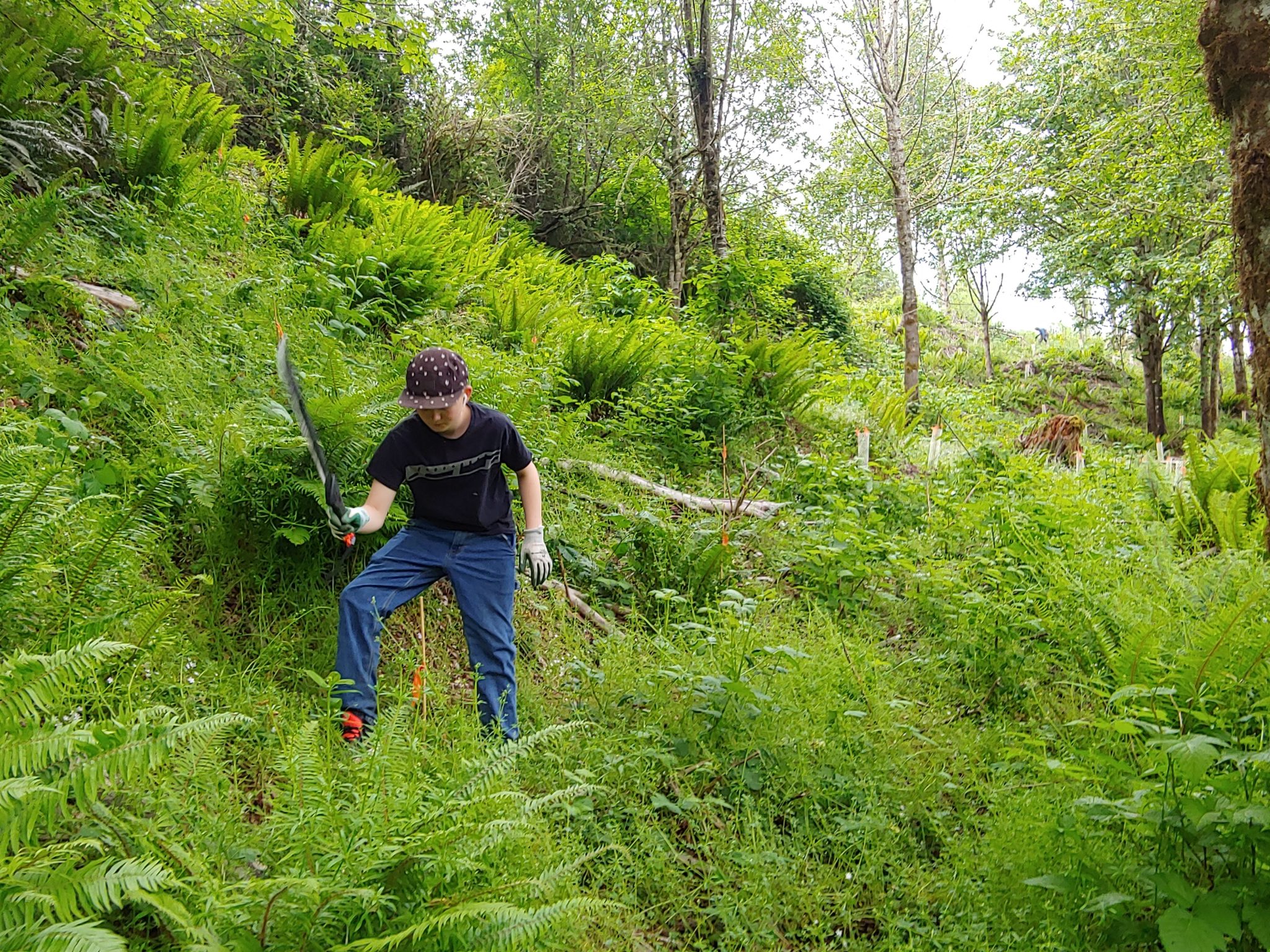
The Hanson family tackles their most ambitious reforestation project ever.
This January the Hansons embarked on a large reforestation project on their forest near Olympia, Washington. Comprising 18 acres and 5,200 seedlings, it’s been their most ambitious planting job to date — one that has had Hanson parents, kids, and grandkids weathering much of the current pandemic from deep in the forest.
Such projects can be intimidating to first-time landowners or those who have never organized seedling planting projects before. Tending to hundreds or thousands of seedlings can be challenging, especially during periods of summer drought. For advice on how to carry out this sometimes-daunting task in a family forest, NNRG didn’t have to look far – our Director of Forestry, Kirk Hanson, is one of the proud ‘kids’ of the Hanson Family Forest. Kirk shared the details and strategy behind every stage of his family’s planting project below, including how they’re preparing their treelings for drier times.
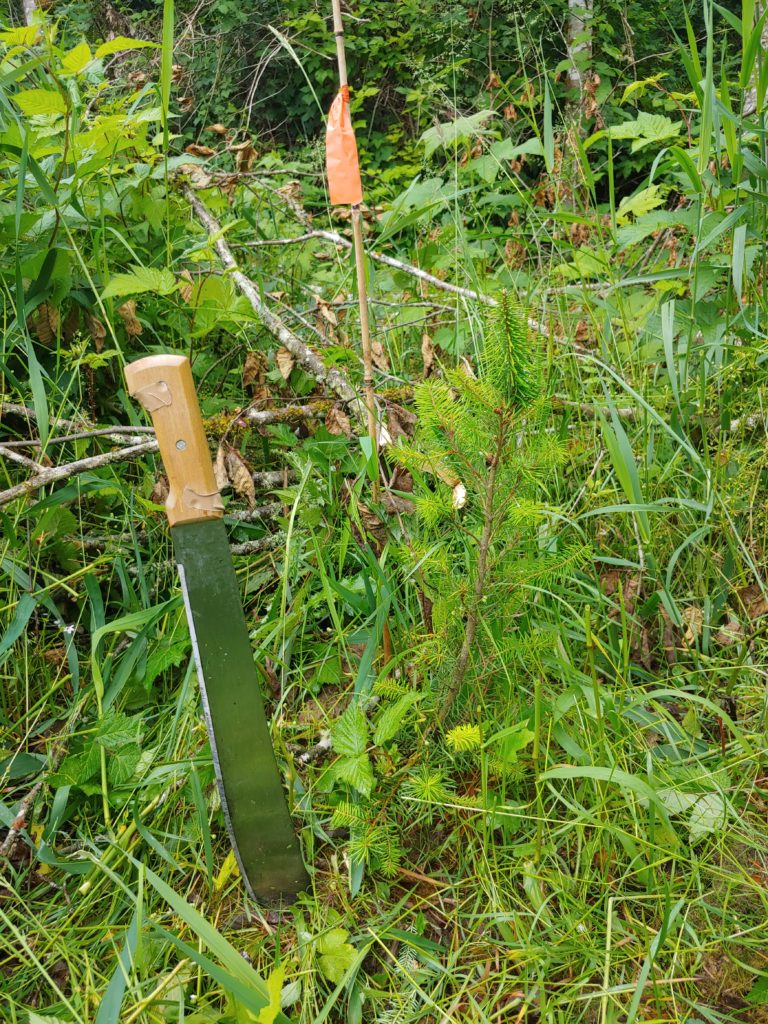
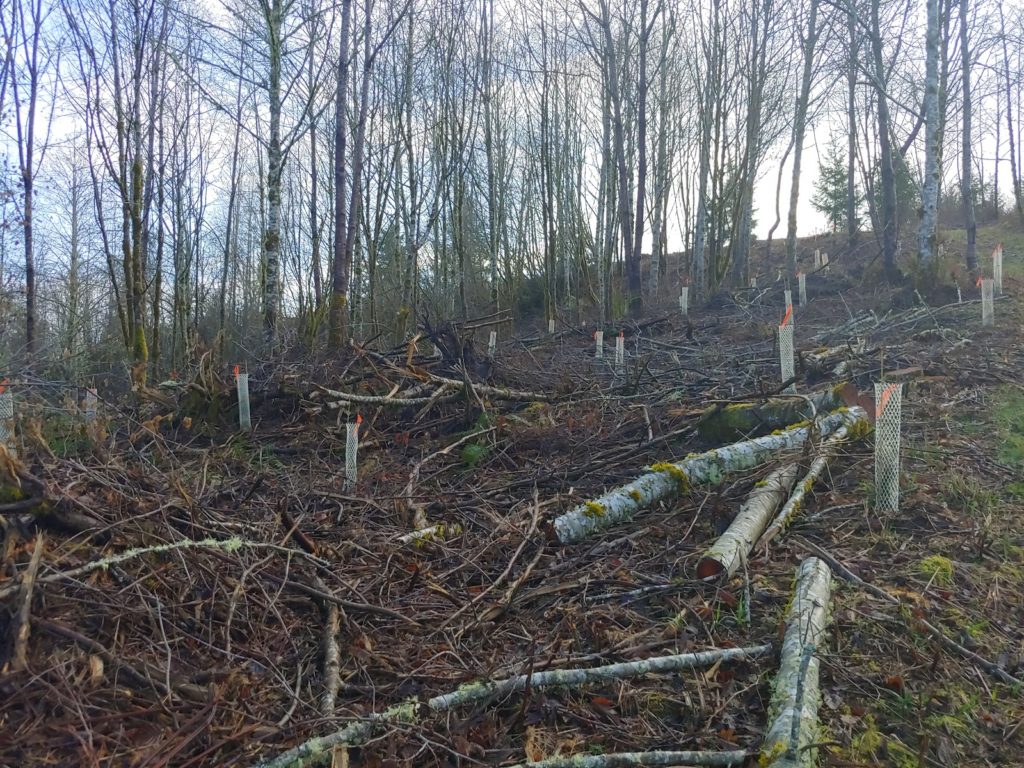
The reasons for planting or replanting seedlings vary by forest and forest steward. Like the Hansons, you may wish to add more species diversity or establish a new cohort of trees to a piece of land that’s been neglected by a previous owner. You may be replanting a patch-cut intended to mitigate the effects of root rot, or underplanting an area with shade-tolerant trees after a selective harvest. Whatever the situation, most planting projects can be divided into four basic stages:
- Applying for cost-share funding for your planting project (Optional)
- Ordering seedlings and/or contracting a planting crew
- Site preparation
- Planting
- Post-planting seedling maintenance
Private forest landowners may organize a planting project entirely on their own, but many choose to work with a forester from, for example: Washington DNR, WSU Extension Service, Oregon Department of Forestry, Oregon State University Extension Service, or a local conservation district. NNRG’s forestry team can also help forest owners with planting projects. Contact us to learn more
Applying for cost-share funding for your planting project
The Hansons were able to pay for their replanting project with funding from the Environmental Quality Incentives Program (EQIP) managed by the USDA’s Natural Resource Conservation Service. EQIP offers cost-share funding, which means the program pays a portion of the expenses of a conservation practice by reimbursing the landowner for a percentage of agreed-upon costs.
The following charts highlight both the costs incurred for site preparation, tree seedlings, materials and planting labor, along with the reimbursement provided by the EQIP.
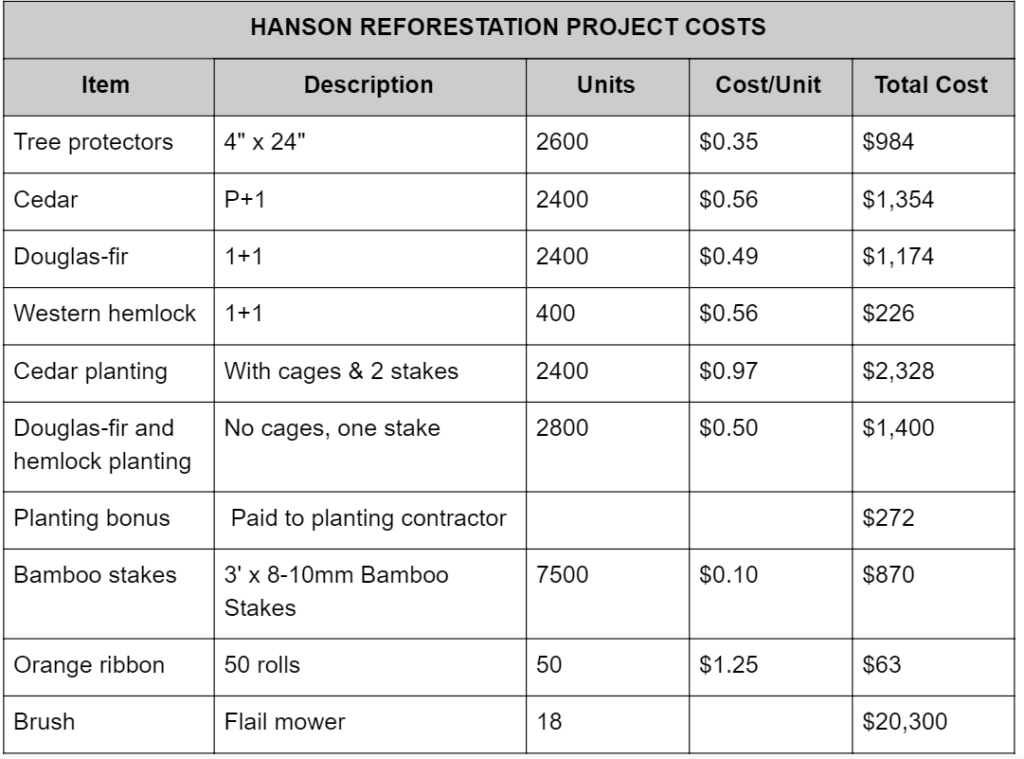
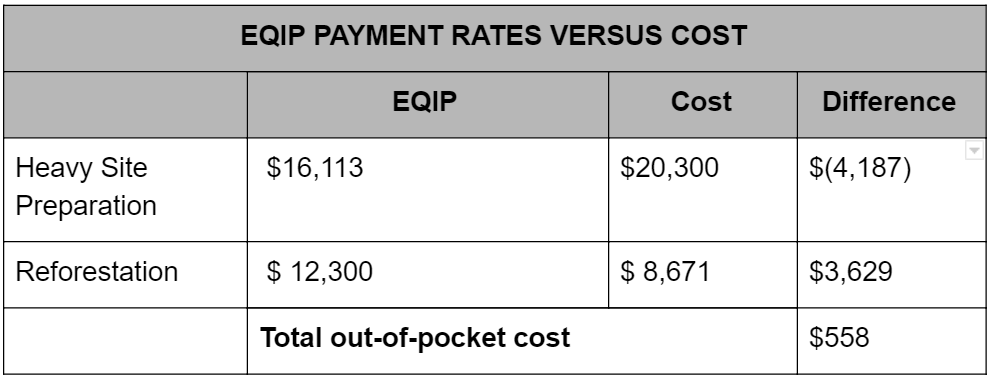
Cost-share funding through EQIP is available to private non-industrial forest landowners – including families, small businesses, non-profits, land trusts and conservation organizations – who harvest less than 2,000 mbf per year. Applications for this program are accepted on a rolling basis; while deadlines for 2021 funding haven’t been announced, they usually occur in mid-January to mid-March, varying by state. Learn more about how to apply for cost-share funding through EQIP.
Several other public agencies offer funding to help forest owners pay for stewardship activities like planting trees. Visit this page to browse other funding sources in Oregon and Washington.
Ordering seedlings and/or contracting with a planting crew
Which seedlings to order
Unless you’re already an expert, a professional forester can provide site-specific recommendations for which seedling species and stock type to plant in your forest. A seedling’s stock type refers to its size, age and suitability for planting into specific sites. For instance, the Hansons ordered the following stock types: Douglas-fir 1+1, Western Red Cedar P+1, and Western Hemlock P+1. 1+1 seedstock designates a seedling grown for one year in a seedbed, harvested, root pruned to five inches and transplanted back into a nursery bed for an additional year. The transplanting process results in a larger caliper (diameter) and a more fibrous root system. The root system on a 1+1, plus the extra storage of food in the caliper and root system, will allow the seedling to survive on an infertile site, compete with other vegetation, and give it a better chance of surviving browse damage.
P+1 (aka Plug +1) seedstock is grown in a greenhouse for a year, the seedling is then extracted from the container, root pruned at 5 inches and transplanted in a nursery bed for an additional year. As with the 1+1, the root pruning and transplanting generates a larger caliper stem and more mass in the root system. Cedar, hemlock, larch and some species of pine and true firs are propagated as Plug+1.
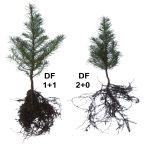
Forest owners typically source seedlings from the same seed zone and elevation as their forest. Increasingly, however, forest managers and owners are considering sourcing seedlings from areas where the climate currently approximates the projected climate of the location of their own forest. The Seedlot Selection Tool (SST) is a web-based mapping application designed to help natural resource managers and forest owners match seedlots (where seedlings are grown) with planting sites based on climatic information. Read more about select seed stock for future climates in NNRG’s 2020 publication, Climate Adaptation Strategies for Pacific Northwest Forests.
How to order seedlings
In a perfect world, the timing of when you order seedlings and contract with a planting crew would be determined by when you wish to plant. Instead, the reverse is often true: the availability of seedlings at nearby nurseries usually determines the earliest you can plant. “Seedlings usually need to be ordered by September if you hope to plant that winter, says Kirk. “You’re not going to get seedlings if you suddenly decided to plant in December or January; by that time they’re already spoken for.”
There are typically two main ways to order seedlings: by ordering them directly from a reforestation nursery, or by contracting with a planting company that batches all of their clients’ seedling orders together, then places a bulk order with a nursery. The Hansons ordered their seedlings from the WA DNR’s Webster Nursery in Olympia, WA in September, and picked up the seedlings themselves prior to planting in early January.
Below is a short list of some tree nurseries in Washington and Oregon. This list is not comprehensive! A simple Google search of Washington and Oregon reforestation nurseries will likely turn up more results, or you can visit Forest Seedling Network to explore a marketplace that connects seedling buyers and sellers.
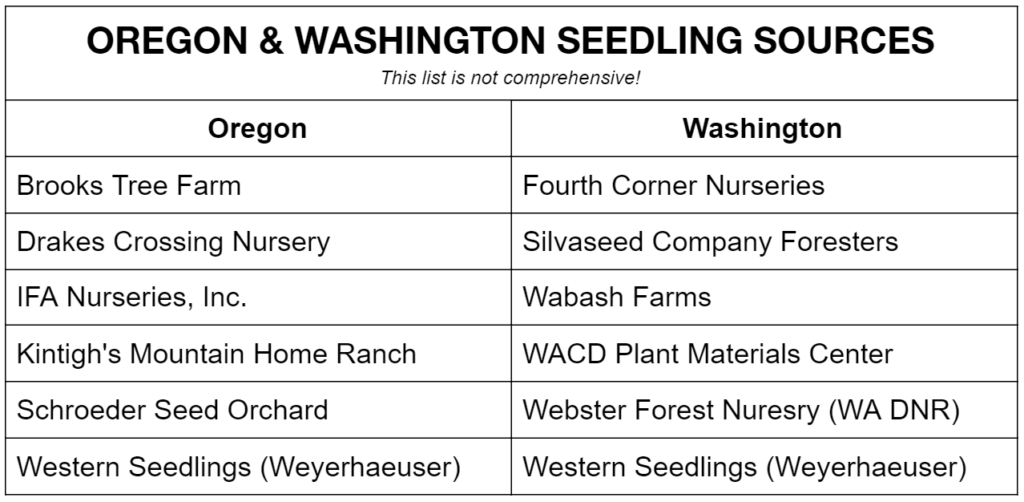
Site preparation
Preparing a site for planting takes different forms depending on existing vegetation, soil conditions, and logging debris. If the site is fairly bare already, site prep may consist only of a little bit of brush or grass clearing. This wasn’t the case at the Hanson Family Forest planting sites, which were covered by dense native and non-native vegetation including salmonberry, Himalayan blackberry, elderberry, and vine maple.
The Hansons used a mini Kuboda excavator with a flail mower head to clear heavy brush within each planting site. Their innovative use of this machine, which Kirk describes as a “like giant lawnmower,” made site preparation a lot faster and more thorough than it would have been had they cleared everything by hand. The Kuboda was even able to operate on relatively steep slopes, and effectively helped to mulch every planting site by leaving all the ground-up brush on the ground.

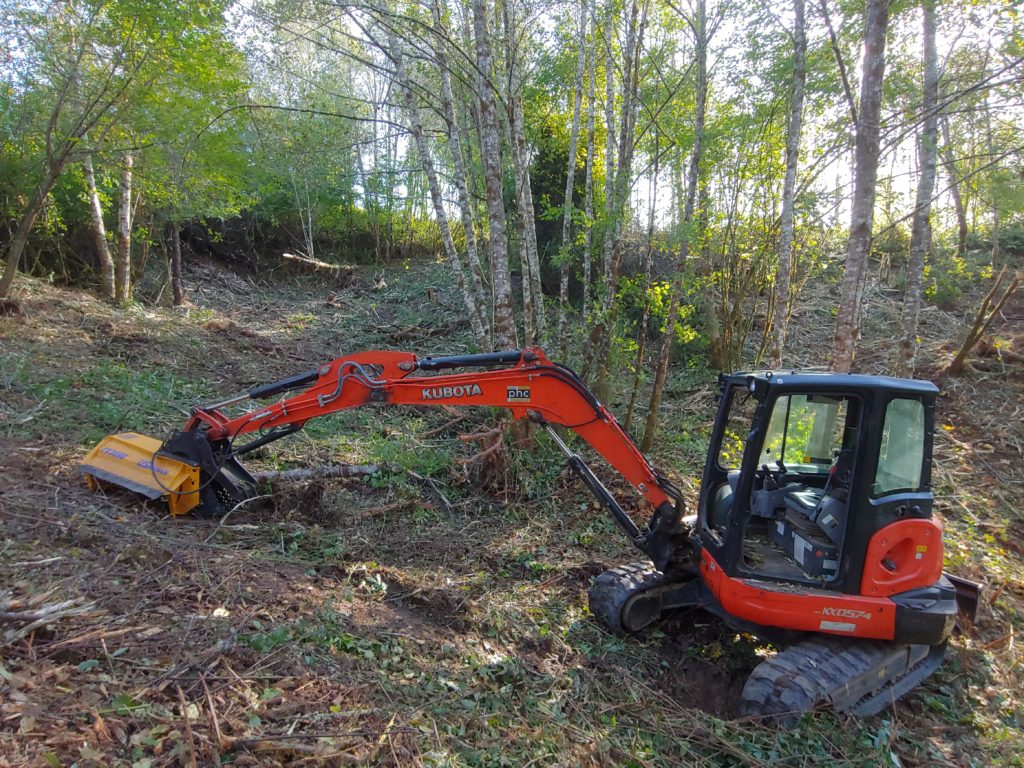
“The standard rule for seedling site prep is to clear all competing vegetation within a 2-3 foot radius of the planting spot,” says Kirk. “The more dense the vegetation, the bigger the spot you’ll want to clear.” It’s also important to clear the space above each seedling to ensure adequate access to sunlight. “I strive for a 45-degree cone of light above each seedling if the surrounding brush is tall,” says Kirk.
Planting
Forest owners often devise a planting strategy for their land with the help of a professional forester. Factors to consider when deciding which species to plant, and where, include:
- Aspect (direction)
- Slope
- Soil type
- Desired stocking density
- Desired species composition
- Quantity and species of existing trees
Aspect
The aspect of a planting site impacts soil moisture. In the Pacific Northwest, sites with a Southern aspect should be planted with species more tolerant of dry soils like Douglas-fir, western redcedar, pine, Pacific madrone, or Oregon white oak.
Slope
A site’s slope determines how much sun or shade seedlings will access, as well as soil moisture. Sites with extremely steep slopes may see less rainfall penetrate the soil as much is lost in runoff. A slope with a southern aspect will have drier soils and more sun exposure than a slope with a northern aspect, which will stay shaded for more of the day. Soil moisture also varies, typically from drier towards the top of a slope and wetter towards the bottom of a slope.
The Hansons concentrated Douglas-fir and western redcedar on more exposed sites and upper slopes as both species grow well in full sun and can tolerate drier sites. Both redcedar and western hemlock were planted on shadier sites with existing trees and along lower slopes as both are shade tolerant and can tolerate soils that are more moist.
Soil Type
Forest owners should know their soil type before planting, as not every species is suited to every type of soil. “Heavy clay and loamy soils will tend to stay a lot wetter than gravelly soils,” says Kirk. Although the soil in the Hansons’ forest is generally of the same type — clay loam — multiple soil types can exist on one property.
Learn more about forest soils and how to determine the type of soil in your area.
Current and desired stocking density
Stocking density — how many trees exist per acre — affects how many trees will compete for sunlight, water, and soil nutrients. It also relates to how much timber will be available for future harvest. And when it comes to newly planted trees, stocking density impacts how much work you’ll be putting into seedling care.
Kirk says, “Standard reforestation density is anywhere from 350-450 trees per acre. I planted at 300 trees per acre, which is a little lower, with the assumption that I’m going to put in a little more attention to those seedlings to make sure they survive. But because there are fewer trees, it’ll take less time overall to tend to them.” More care per seedling, fewer seedlings.
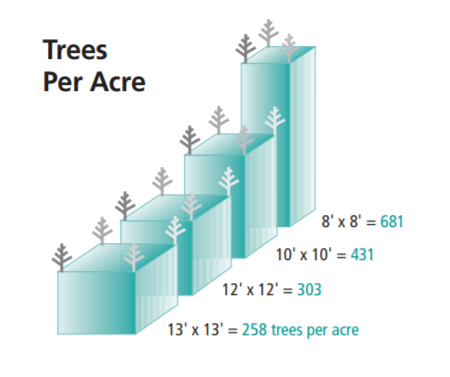
A stocking density of 300 trees per acre had the Hansons planting trees 12-15 feet apart. The approach you take to planting density depends on the level of effort you wish to put into seedling care, whether you plan to do pre-commercial thinning in the future, the natural regeneration happening on the site and/or presence of existing trees, your budget, and recommendations from your forester.
The Hansons chose to hire a professional tree planting crew to install the 5,200 tree seedlings on their land. “I can plant about 100 trees per day,” says Kirk, “but after that the novelty wears off.” The professional crew, composed of eight tree planters, planted all 5,200 seedlings, including installing tree cages on the cedar, in two days. Typical planting costs tend to hover around $1 per seedling ($0.50 to purchase the seedling, $0.50 to plant it). Planting costs for the Hansons’ project ranged from $0.50/seedling for Douglas-fir and western hemlock, to $0.97/seedling for the cedar, which included placing plastic mesh browse protectors over the seedlings. The Hansons also had the planters place a 3’ bamboo stake with fluorescent orange flagging next to each tree to aid in finding the seedling during future brush control.
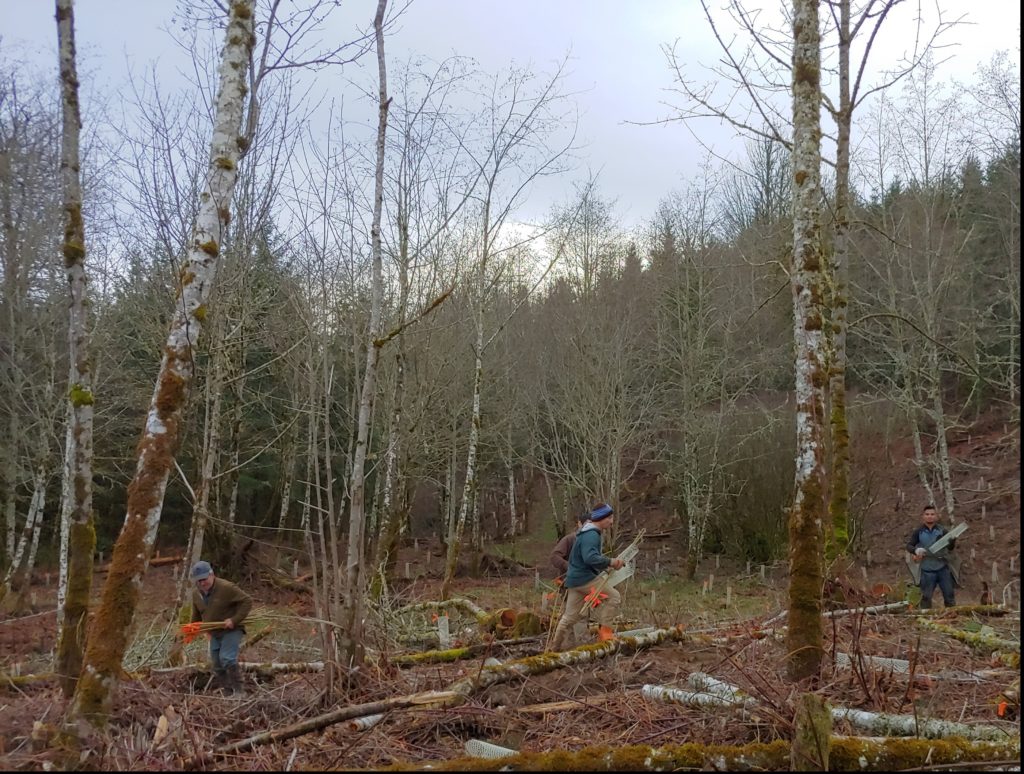
Keep in mind that Washington and Oregon state laws require replanting after harvests, and also require a minimum number of surviving seedlings per acre.
“Current reforestation regulations require a minimum of 190 healthy trees evenly distributed per acre (approximately 15’ x 15’) in western Washington and 150 healthy trees evenly distributed per acre (approximately 17’ x 17’) in eastern Washington. Successful reforestation is required within three years of timber harvest (WAC 222-34).”
“Landowners must complete replanting of harvested ground within two years. Within six years of harvest, the young trees must be “free-to-grow.” That means they are vigorous and tall enough to out-compete grass and brush, and will grow into a new forest. Depending on the site, the rules require that at least 100 to 200 trees per acre survive during reforestation.”
Current and desired species composition
As we mentioned earlier (and we’ll keep saying it!) it’s best to work with a forester to determine which species to plant in your forest. Some forest owners may be planting with the goal of creating a more diverse forest, and so may choose to plant species underrepresented in a particular stand. Others may be planting with an eye to economic returns and thus focus on timber species. In this year’s big planting project, the Hansons were aiming for both. All three species they planted have significant future commercial value, and both the cedar and hemlock only occurred in low numbers on their land prior to replanting.
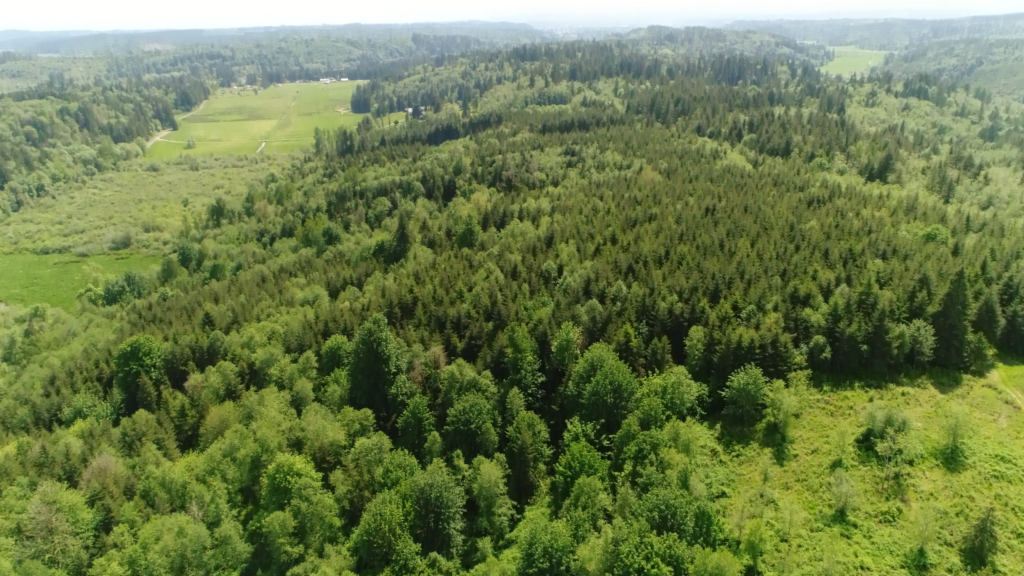
Kirk says his family took the natural regeneration happening on some sites into account when deciding which species to plant. “I’m getting a lot of grand fir and some Douglas-fir seeding into my young plantations. That’s going to increase the overall stocking density over time, so I deliberately didn’t plant grand fir because it’s already there and reseeds prolifically. One of the planting sites was also a failed alder plantation attempted by the previous landowner. However, some alder survived, in patches and sparse individuals, so we instructed the tree planters to maintain a planting distance of 12’ from each existing tree or seedling.”
Post-planting seedling maintenance
Once you and/or a planting crew have safely ensconced every seedling in a nice, brush-free spot, the work isn’t over. It’s important to ensure your seedlings are getting adequate sunlight, water, and nutrients to thrive. “You’re going to be coming in every year between late May and early July to cut back competing vegetation within that same two to three foot radius around the seedling,” says Kirk. This is often called ‘seedling release’. “And you’re going to be doing that until the seedling reaches a free-to-grow height.”

A young tree is typically considered ‘free-to-grow’ when its leader (the top of the tree) is one to three feet above the surrounding vegetation. It could take two to five years for the seedlings to reach free-to-grow height, depending on the species and the site productivity. Until then, expect to invest in some serious labor every spring. Dry planting sites are especially important to keep clear, as competing vegetation will gleefully suck moisture from the soil around seedlings.
Seedling release is usually done manually with a machete or brush cutter. Forest stewards may also choose to use herbicide to control competing vegetation.
“We considered spraying around planting sites,” says Kirk, “but ultimately decided we wanted to avoid poison in the forest.” Instead, the Hansons are clearing brush manually, and they have it down to an exact science. “It takes about one minute per seedling to clear whatever is around it. We planted 300 seedlings per acre, so that’s 5 hours of work per acre.”
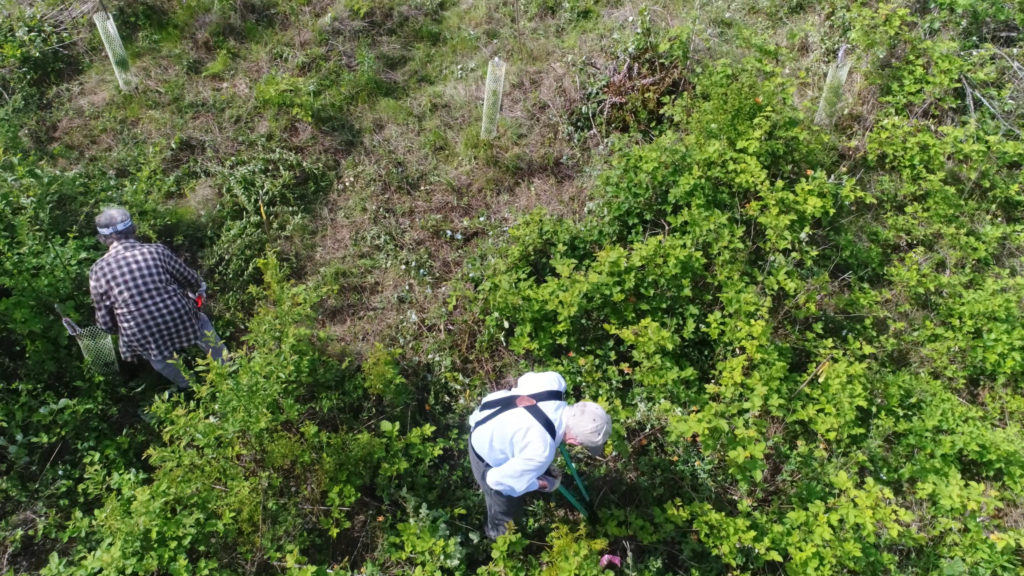
The Hansons have 18 acres of plantings to tend, so three generations of Hansons are tackling the enormous seedling release project together. Kirk’s octogenarian and nonagenarian parents, affectionately known as Ma and Pa Hanson, have spent some of the current pandemic vigorously cutting brush from their young trees.
For his part, Pa (Rod) Hanson uses a handy cane/machete combination tool that he fabricated by bolting a machete sheath onto his walking cane to cut back blackberries.
The grandparents also employ Kirk’s teenage kids to cut back competing vegetation from around tree seedlings. The kids relish the opportunity to brandish machetes, mostly avoiding one another, and Ma & Pa Hanson pay them an hourly rate for their labor.
The EQIP provides $90/acre for competing vegetation control, and the Hansons are passing this money straight through to their grandkids (half must be saved in the bank for future college expenses).
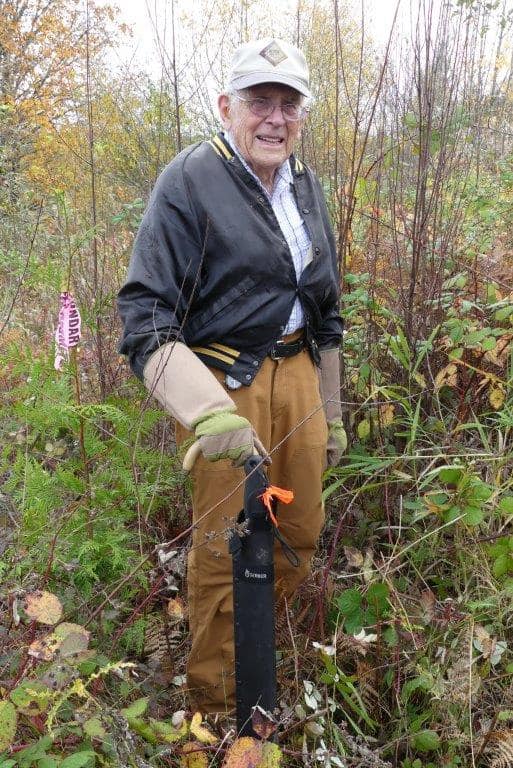
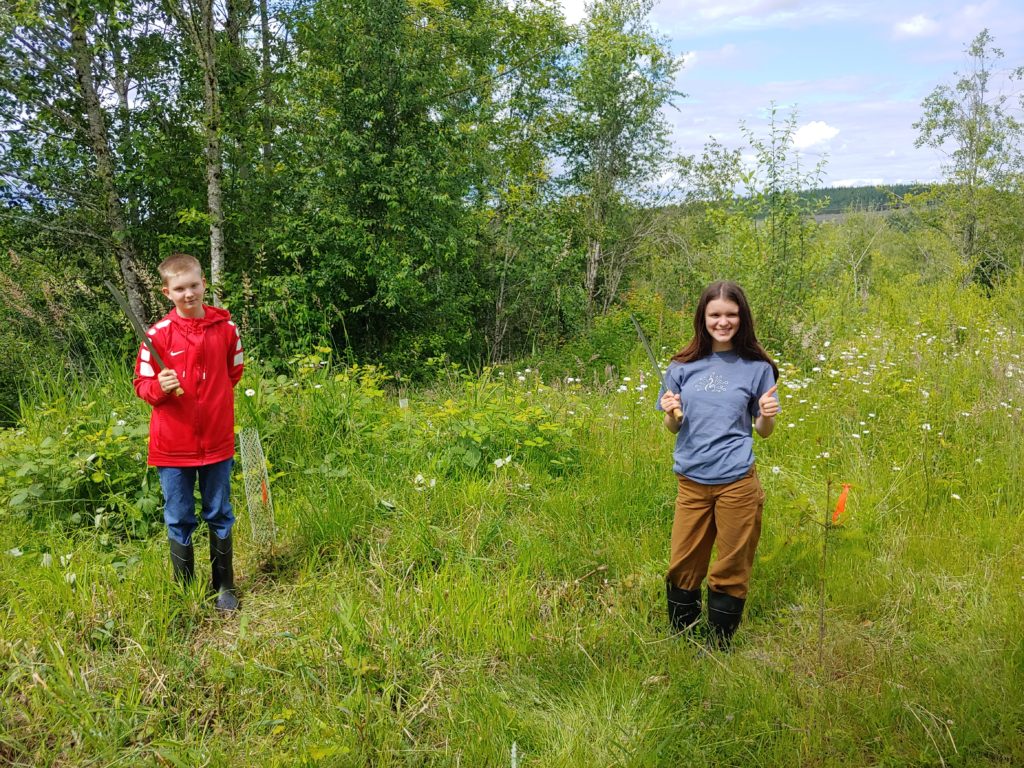
Conclusion
“Planting trees is one of the most rewarding experiences of owning a small woodland,” Kirk said. “Other than being a parent, I can’t think of anything more existentially gratifying than planting a tree that has the potential to live hundreds, even thousands, of years. These trees will also provide valuable income to my kids, and their grandkids. In as little as 30 years I estimate that each acre we planted this year will grow approximately 15 thousand board feet (MBF) of timber. At a conservative estimate of $550/MBF, that’s a total value of $148,500 across the entire 18 acres. The trees will sequester carbon, provide wildlife habitat, clean air, clean water. What other investment provides those kinds of dividends?”
Summary of Tips & Resources
Applying for cost-share funding for your planting project
- EQIP is a program that helps pay for stewardship activities in your forest. Cost-share funding through EQIP is available to private forest landowners that harvest less than 2,000 mbf per year. Applications are accepted on a rolling basis.
- More information about EQIP
- More information about other cost-share assistance options
Ordering seedlings and/or contracting a planting crew
- Talk to a forester about which seedling species and stock type to plant in your forest.
- Forest owners typically source seedlings from the same seed zone and elevation as their forest.
- The Seedlot Selection Tool (SST) is a web-based mapping application designed to help you match seedlots (where seedlings are grown) with planting sites based on climatic information.
- Order seedlings far in advance of planting! Usually by September, to plant in the winter.
- Ordering them directly from a reforestation nursery, or by contracting with a planting company
Visit Forest Seedling Network to explore a marketplace that connects seedling buyers and sellers.
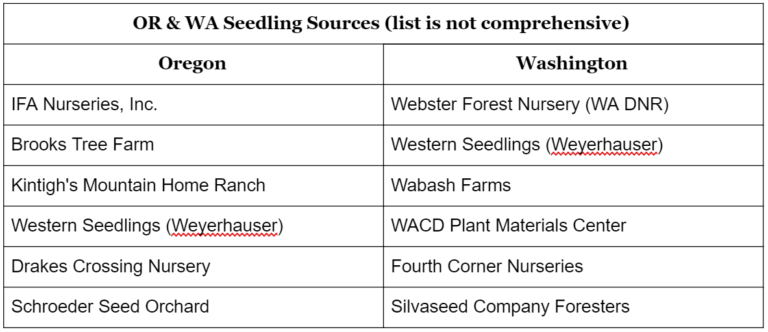
Site preparation
- Clear all competing vegetation within a 2-3 foot radius of the planting spot.
- Maintain a 45 degree cone of sunlight and open space above each seedling.
Planting
- Standard reforestation density is 350-450 trees per acre.
- Planting costs tend to hover around $1 per seedling ($0.50 to purchase the seedling, $0.50 to plant it).
- Washington and Oregon state laws require replanting after harvests, and also require a minimum number of surviving seedlings per acre.
Post-planting seedling maintenance
- Re-visit planting sites every year in spring and early summer to cut back vegetation within 2-3 foot radius of seedlings & ensure seedlings are getting adequate sunlight, water, and nutrients.
- Cut back vegetation until seedling reaches free-to-grow height: when the leader (the top of the tree) is 1-3 feet above the surrounding vegetation.
- Seedling release is usually done manually with a machete or brush cutter. Forest stewards may also choose to use herbicide to control competing vegetation.
Other resources on planting trees
- Washington DNR
- OSU Extension Service
- WSU Extension Service
- King Conservation District

Leave a Reply